Number of new constructions increased by 64.5 percent
The total number of new construction projects from approved building permits during the fourth quarter of 2017 was 495, reflecting a 64.5 percent increase from 301 constructions during the same period in 2016.
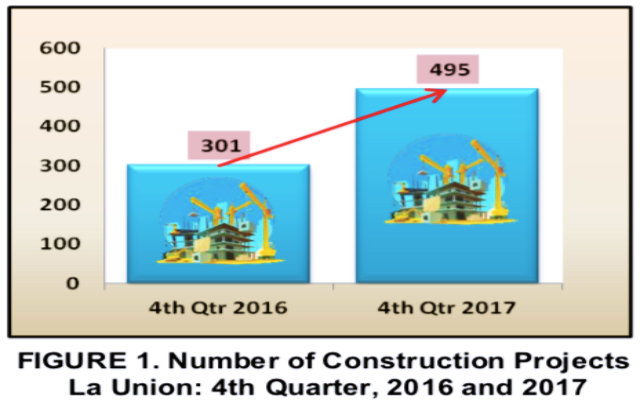
Residential type buildings recorded the highest number of constructions during the fourth quarter of 2017 with a total of 388 constructions. This figure posted an increase of 57.7 percent from the 246 residential buildings reported in the same period a year ago. Moreover, non-residential building constructions abruptly increased by 113.2 percent to 81 from 38 constructions during the same period of 2016.
Furthermore, the combined number of additions, alterations and repairs of existing structures also increased by 52.9 percent to 26 constructions during the fourth quarter of 2017 from 17 constructions in the same period last year.
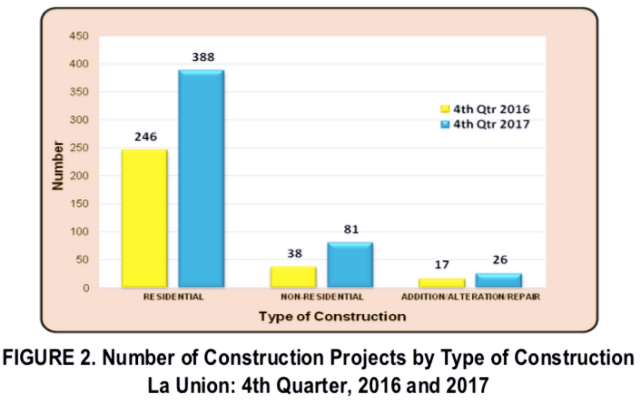
Value of building construction projects reached Php692.6 million
The total value of construction projects during the fourth quarter of 2017 went up by 75.7 percent to Php692.6 million from Php394.3 million recorded during the same quarter of 2016.
By type of construction, residential building constructions accounted the biggest share in terms of the value of constructions in both periods. The value of new residential building constructions increased by 59.7 percent during the fourth quarter of 2017 amounting to Php383.6 million from Php240.2 million in the same quarter of 2016.
Moreover, the value of new non-residential constructions posted an increase of 90.2 percent to Php264.6 million during the fourth quarter of 2017 from Php139.1 million during the same period last year.
Similarly, the aggregated value for additions, alterations and repairs greatly increased by 195.2 percent with an estimated value of Php44.5 million during the fourth quarter of 2017 from Php15.1 million during the same period of 2016.
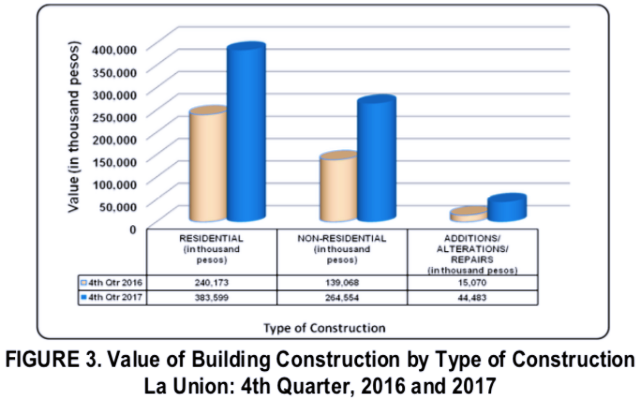
Average cost per square meter of residential construction is Php9,195
The total value of all residential building constructions within the province reached Php383.6 million with a total floor area of 41,720 square meters. This translates to an average cost of Php9,195 per square meter.
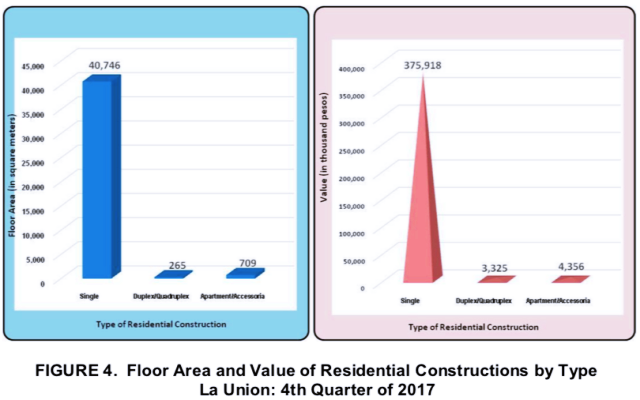
Single-type residential units, comprising 98.7 percent of the total residential constructions, topped over all other types of residential constructions. There were 383 single-type residential units covering a total floor area of 40,746 square meters and an aggregate value of Php375.9 million. This translates to an average cost of Php9,226 per square meter.
There were only three apartment/Accesoria type of residential constructions recorded or 0.8 percent of the total residential constructions. It has an estimated construction value of Php4.4 million with a total floor area of 709 square meters or an average cost of Php6,144 per square meter.
For duplex/quadruplex, there were two recorded or 0.5 percent of the total residential constructions. It has an estimated construction value of Php3.3 million with a total floor area of 265 square meters or an average cost of Php12,547 per square meter.
Average cost per square meter for non-residential construction is Php8,917
The total value of all non-residential constructions was estimated at Php264.6 million with a total floor area of 29,670 square meters. The computed average cost per square meter was Php8,917.
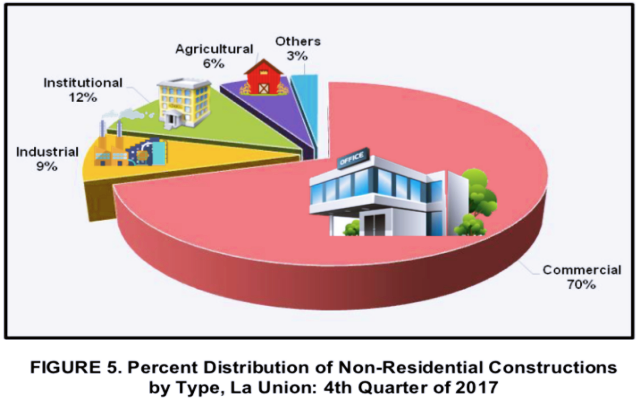
Commercial-type building constructions posted the biggest number of non- residential constructions with 57 construction projects or 70.4 percent of the total non-residential constructions. The total value of constructions for this type was estimated at Php158.4 million covering a floor area of 21,805 square meters or an average cost of Php7,265 per square meter.
Institutional buildings distantly followed with ten constructions or 12.3 percent of the total non-residential constructions. Total value for these projects was estimated at Php81.4 million with a total floor area of 5,823 square meters or an average cost of Php13,981 per square meter.
Moreover, industrial buildings ranked third accounting for 8.6 percent (7 constructions) of the total non-residential constructions. It has a construction value of Php20.5 million with a total floor area of 1,446 square meters, indicating an average cost of Php14,151 per square meter.
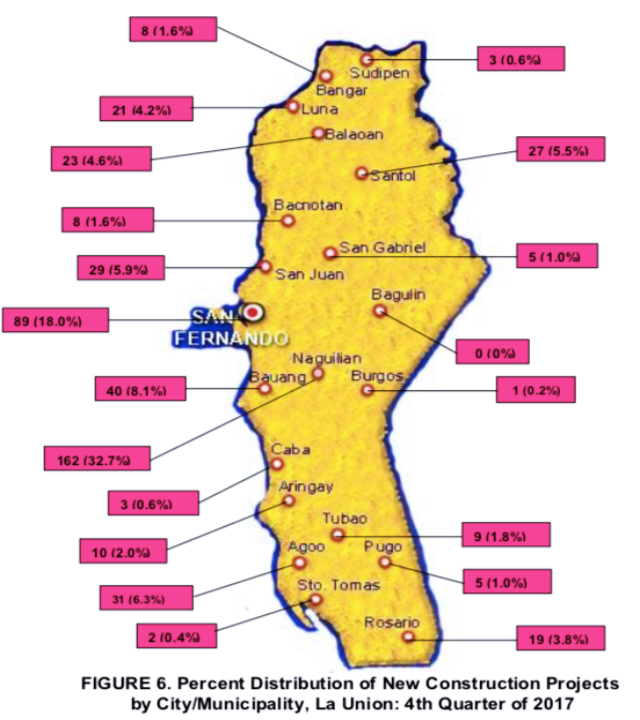
The figure above shows the distribution of approved building permits by city/municipality in La Union during the fourth quarter of 2017.
Among the city/municipalities, the municipality of Naguilian registered the highest number of construction projects with a share of 32.7 percent (162 constructions) to the total approved building permits in La Union during the fourth quarter of 2017. Compared with the number of constructions in the same period last year (76 building constructions), it registered an increase of 113.2 percent.
Other city/municipalities with high number of construction projects in the fourth quarter of 2017 included the City of San Fernando with 89 constructions (18.0 percent share) and municipality of Bauang with 40 constructions (8.1 percent share).
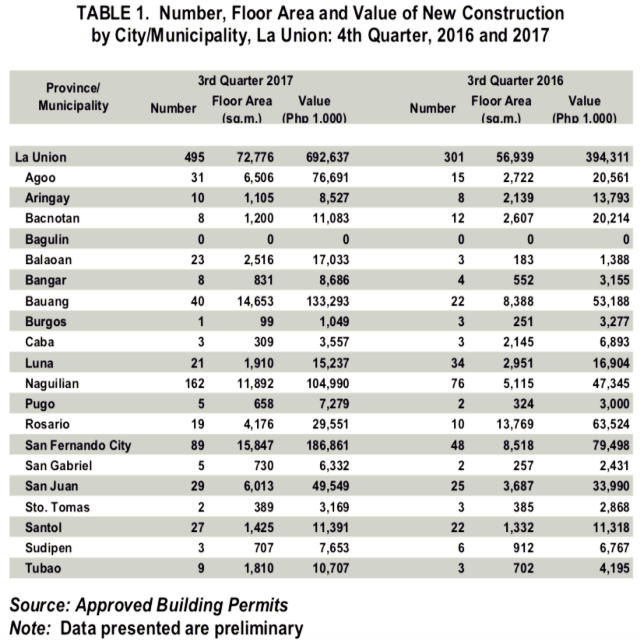
Entire the province, the City of San Fernando occupied the top rank in terms of the value of constructions during the fourth quarter of 2017 with a share of 27.0 percent (Php186.9 million) to the provincial total. The municipality of Bauang and Naguilian ranked second and third with shares of 19.2 percent (Php133.3 million) and 15.2 percent (Php105.0 million) respectively.
In the same period of 2016, the City of San Fernando had also the highest value of construction projects among the municipalities contributing 20.2 percent (Php 79.5 million) to the provincial total. The municipality of Rosario ranked second with a share of 16.1 percent (Php63.5 million) while the municipality of Bauang placed third with a share of 13.5 percent (Php53.2 million).
TECHNICAL NOTES
Scope and Coverage
Private construction statistics from approved building permits pertain to data on new constructions and additions, alterations and repairs of existing residential and non-residential buildings and other structures undertaken in all city/municipalities of the country.
For this publication, the scope and coverage are all city/municipalities in La Union.
Source of Information
Data were taken from the original application forms of approved building permits collected every month by PSA field personnel from the offices of Local Building Officials (LBOs) provincewide.
Limitation
1. Data on private building constructions refer to those proposed to be constructed during the reference period and not to construction work completed during the reference period.
2. The completeness of the number of building permits collected relies on the collection of applications filed with the LBOs. Hence, private building constructions without approved building permits are excluded in the tabulation of data.
Definition of Terms
Building Permit is a written authorization granted by the LBO to an applicant allowing him to proceed with the construction of a specific project after plans, specifications and other pertinent documents have been found to be in conformity with the National Building Code (RA 6541).
Building is any independent, free-standing structure comprised of one or more rooms or other spaces, covered by a roof and enclosed with external walls or dividing walls which extend from the foundation to the roof.
Residential Building is a building for which its major parts or more than half of its gross floor area is built for dwelling purposes. This type of building can be of the single type, duplex, an apartment and/or accessoria.
Single House is a complete structure intended for a single family or household, i. e. bungalow, two-storey house, nipa hut.
Duplex is a structure intended for two households, with complete living facilities for each; it is a single structure divided into two dwelling units by a wall extending from the floor to the ceiling.
Apartment is a structure, usually of several storey made up of independent living quarters, with independent entrances from internal walls and courts.
Accessoria is a one or two-floor structure divided into several dwelling units having their own separate entrances from outside.
Other Residential Constructions consist of school or company staff houses, living quarters for drivers and maids and guardhouses.
Non-Residential Building includes commercial, industrial, agricultural and institutional buildings.
Commercial Building includes office buildings and all buildings which are intended for use primarily in wholesale, retail and service trades; i.e. stores, hotels, restaurants, banks, disco houses, etc.
Industrial Buildings are buildings which are used to house the production, assembly and warehousing activities of industrial establishments; i.e. factories, plants, mills, repair shops, machine shops, printing press, storage plant, electric generating plants.
Institutional Buildings are buildings which are primarily engaged in providing educational instructions and hospital/health care; ports, airports and other government buildings; i.e. schools, museums, libraries, sanitaria, churches, hospitals.
Agricultural Buildings are buildings which are used to house livestock, plants and agricultural products such as barn, poultry house, piggeries, stables, greenhouses and grain mill.
Other Non-Building Constructions include cemetery structures, street furniture, waiting sheds, communication towers, etc.
Addition refers to any new construction which increases the height or area of an existing building/structure.
Alteration refers to construction in a structure involving changes in the materials used, partitioning, location/size of openings, structural parts, existing utilities and equipment but does not increase the overall area thereof.
Repair refers to remedial work done on any damaged or deteriorated portion/s of a structure to restore its original condition.
Floor Area of Building refers to the sum of the area of each floor of the building measured to the outer surface of the outer walls including the area of lobbies, cellars, elevator shafts and all communal spaces in multi-dwellings. Areas of balconies are excluded.
Total Value of Construction refers to the sum of the cost of building, electrical, mechanical, plumbing, and others. The value is derived from the approved building permit and represents the estimated value of the building or structure when completed.
SGD. DANITES E. TEÑIDO, Ph.D.
(Statistical Specialist II)
Officer-in-Charge

